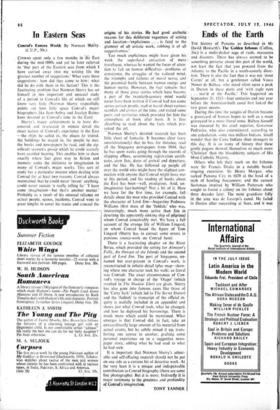In Eastern Seas
Comma spent only a few months in the East during the mid-1880s and yet he later referred to 'that part of the Eastern seas from which have carried away into my writing life the greatest number of suggestions.' What were these suggestions: how did they come to him: what did he do with them in his fiction? This is the fascinating problem that Norman Sherry has set himself in this important and unusual study of a period in Conrad's life of which we still know very little (Norman Sherry respectfully points out how little space Conrad's major biographers like Jean-Aubry and Jocelyn Baines have devoted to Conrad's time in the East).
Sherry's major achievement is to have dis- covered and re-created in minute detail the exact nature of Conrad's experience in the East —the ships he sailed in, the places he visited, the buildings he stayed in, the people he met, the books and newspapers he read, and the sig- nificant seamen's gossip which he could scarcely have avoided hearing. This enables him to show exactly where fact gives way to fiction and memory cedes the initiative to imagination, in many of Conrad's major works. This sort of study has a particular interest when dealing with Conrad for at least two reasons. Conrad always maintained that he could never 'invent' anything, could never sustain 'a really telling lie.' I have some imagination—but that's another matter.' Probably as a result of his unusual reliance on actual people, scenes, incidents, Conrad went to great lengths to cover his traces and conceal the origins of his stories. He had good aesthetic L reasons for this deliberate vagueness of setting and location----`explicitness . . . is fatal to the glamour of all artistic work, robbing it of all suggestiveness.'.
Too much explicitness might have given his work the superficial attraction of mere travelogue, whereas he wanted the focus of atten- tion to fall on human difficulties—problems of conscience, the struggles of the isolated mind, the triumphs and failures of moral nerve, and - the perennial battle between human energy and human inertia. However, the fact remains that many of those great stories which have become a part of the twentieth-century mind would never have been written if Conrad had not come across certain people, read or heard about various scandals and crimes of the time, and visited some ports and territories which provided for him the atmosphere of book after book. It is thus absorbing to read about the facts which pro- voked the art.
Norman Sherry's devoted research has been
little short of fantastic. It becomes clear (very unostentatiously) that he has, for instance, read all the Singapore newspapers from 1844; that he has spent weeks going through the records of shipping offices, scrutinising registration certifi- cates, crew lists, dates of arrival and departure, and the like. He has followed up people all over the world who might have the slightest con- nection with anyone that Conrad might have met at this period, and his reading of books about the East has been—well, prodigious. Arid, un- imaginative fact-hunting? Not a bit of it. Here we have for the first time, for example, full : details about the man who provided Conrad with the character of Lord Jim—Augustine Podmore Williams (first mate of the 'Jeddah,' who was,
interestingly, much more active than Jim in deserting the apparently sinking ship of pilgrims) whom Conrad conceivably met. We have a full account of the strange life of William Lingard, on whom Conrad based the figure of Tom Lingard (Sherry has to correct some errors in previous source-work on Conrad here).
There is a fascinating chapter on the River
Reran, which provided the setting for Almayeis Folly, An Outcast of the Islands and the second part of Lord Jim. The port of Singapore, un- named but ever-present in Conrad's work, is reconstructed in infinite detail (plus map—show- ing where one character took his walk; so literal was Conrad). The exact circumstances of Con- rad's voyage in charge of the 'Otago' (which resulted in The Shadow Line) are given. Sherry has also gone into famous cases like those of the `Cutty Sark' (which led to The Secret Sharer) and the 'Jeddah' (a transcript of the official in- quiry is usefully included in an appendix) and shows just what Conrad took, what he changed, and how he deployed his borrowings. There is much more which could be mentioned. What emerges is that Conrad did, in fact, take an extraordinarily large amount of his material from actual events, but he subtly mixed it up, trans- ferring one source to another, grafting some personal experience on to a suggestive news- paper story, adding what he had read to what he had seen.
It is important that Norman Sherry's admir-
able and self-effacing research should not be put on one side as a curious bit of detective work. At the very least it is a unique and indispensable contribution to Conrad biography (there are some fine photograph). But it is more. Indirectly it is major testimony to the greatness and profundity of Conrad's imagination.
TONY TANNER






























 Previous page
Previous page